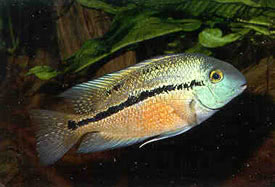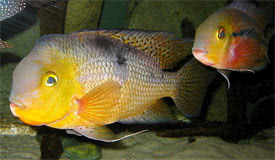
 Magyarul / Hungarian
Magyarul / Hungarian


- Scientific name: Hypsophrys nicaraguensis
- Common name: Nicaragua Cichlid, Nicaraguense, Spilotum
- Group: Cichlids
- Habitat: Central America; Nicaragua, Costa Rica.
- Size: 20 cm.
- Biotope: Still and slow-moving water with rocky areas.
- Social behavior: A territorial, but relatively peaceful fish. Combine with other Cichlasoma species. Fish defending eggs or fry will become aggressive. Pairs form a patriarch-matriarch family and are fine parents.
- Diet: Live, fish, insect larvae, shrimp, snails, earthworms, pellets, flake, vegetables, raw meat, mussels.
- Breeding: Quite easy
- Tank: Minimum 200 litres:
- Population: 1 couple for 300 litres
- Decoration: Provide hiding places with roots, caves, rocks, and wood. Use fine gravel or preferably, sand, as a substrate. Hardy, well-rooted plants can be used, since this fish usually does not eat them.
- Temperature: 25-26°C
- pH: 6.7-8
- Hardness: 4-20 NK°
- Lifespan: 10-15 years
Description: An elongated, oval-shaped, laterally compressed cichlid. The head is rounded and the mouth is small. The caudal fin is fan-shaped and the pectoral fins are large. The eye is golden yellow to amber. Juvenile fish are gray to brown in color with a black lateral line that extends from the eye to the caudal fin. The adult coloration depends entirely on the geographic population of the fish. Two common color morphs are from Nicaragua and Costa Rica. The Nicaragua morph has a golden body color with a beige head. The parts below the gill cover to the middle part of the belly are a delicate lavender. The female has a black lateral stripe that extends from just behind the eye, back to the caudal fin. This stripe is absent or barely detectable in the male, often the only trace being a black spot located near the fish's mid-section. The morph from northern Costa Rica has a pastel blue-green colored head and back with a lavender region below the gill cover. The light green back gives way to lavender hues before reaching the lateral stripe. This purple lateral stripe extends from behind the eye and back to the caudal fin. The belly is a light gold color. The fins are quite colorful. The base of the dorsal fin is yellow becoming green, the turquoise on the edge. The rear tip of this fin is red in color. The others fins are similarly colored. The male has a bright green head and a bright yellow back. A black lateral stripe from behind the eye to the caudal fin. Below this stripe, the body is orange-red. The dorsal fin is yellow with the last few rays being green. The dorsal and pelvic fins are lavender.
Males grow larger and develop a small hump. Females usually have more color. Males have a pointed genital papilla.
The problems that arrive with spawning C. nicaraguensis usually deal with the incompatibility of a pair. Once this obstacle is overcome, breeding comes fairly easily. Use water with a temperature from 79-82°F (26-28°C). The pair digs a large pit, using their mouths, under a rock or in a cave. The eggs are laid in the pit. They are not adhesive, but rest on the substrate in the pit. Usually only 20-50% of the eggs laid will hatch, although if the male is not fully mature, a smaller percent yield can be expected. The eggs hatch in 3 days, and the fry are free-swimming 4-5 days thereafter. Both parents participate in brood care; with the female fanning and guarding the eggs and fry, and the male guarding the territory. Start feeding with Artemia nauplii.





















